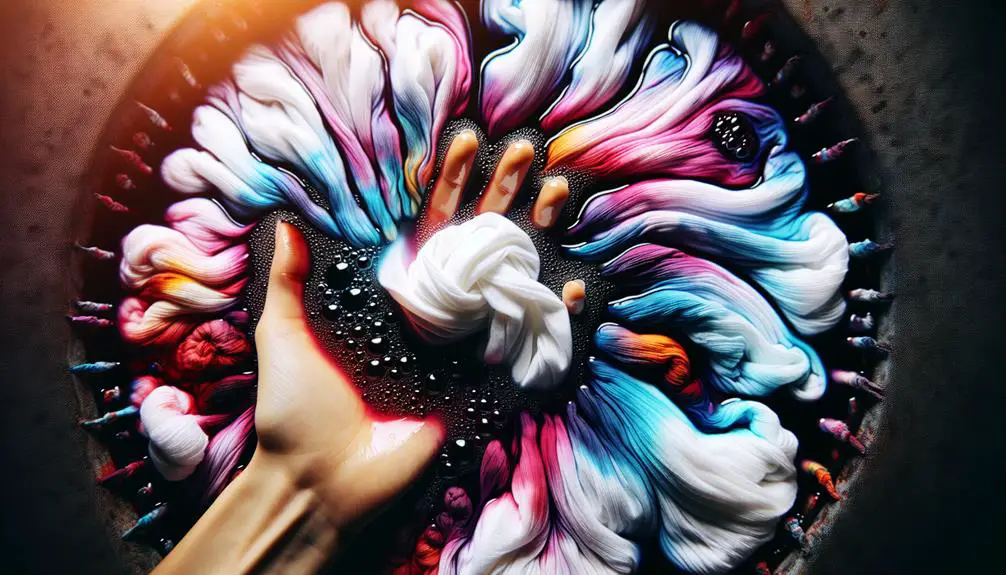Dyeing silk may seem intimidating at first, but did you know that with the right techniques and materials, it can be a rewarding experience?
The process of dyeing silk opens up a world of creative possibilities, allowing you to transform this luxurious fabric into vibrant and personalized pieces.
From choosing the right dye to exploring various dyeing methods, there are essential factors to consider when embarking on a silk dyeing project.
So, how exactly can you achieve those stunning colors on silk?
Table of Contents
Key Takeaways
- Silk can be dyed using various methods like hot dyeing and solar dyeing.
- Choosing high-quality silk types is crucial for vibrant and long-lasting colors.
- Silk scarves offer a versatile canvas for experimenting with different dyeing techniques.
- Achieving black silk dye requires specific dyeing methods and safety precautions.
Silk Dyeing Methods
When dyeing silk, various methods such as hot dyeing, solar dyeing, eco printing, bundle dyeing, and Hapazome are employed to create a range of colors and prints. Silk, being a protein fiber, interacts well with natural dyes and can withstand hot water during the dyeing process without felting.
Each method offers unique results in terms of color vibrancy and patterns. Hot dyeing, for instance, is a reliable method for achieving consistent and vivid colors on silk fabrics. Solar dyeing, on the other hand, harnesses the power of sunlight to activate dyes, resulting in more organic and unpredictable patterns. Eco printing involves using natural plant materials to create prints on silk, while bundle dyeing and Hapazome techniques produce one-of-a-kind designs by directly applying dyes onto the fabric.
Understanding these different dyeing methods is crucial for mastering the art of creating stunning colors and prints on silk textiles.
Choosing the Right Silk for Dyeing
To achieve optimal results when dyeing silk, it's essential to select high-quality silk types like Pongee, Habotai, or Silk satin for their superior dye absorption properties. These silk varieties are known to absorb dyes evenly, ensuring vibrant and long-lasting color on the fabric.
When choosing silk for dyeing projects, it's crucial to consider factors such as the weave and weight of the silk fabric. Fabrics with a smooth texture and natural sheen tend to yield the best results with natural dyes, producing rich and vibrant colors. Silk that's 100% natural fiber is recommended to avoid any unpredictable outcomes during the dyeing process.
Dyeing Silk Scarves
Silk scarves provide a versatile and vibrant canvas for exploring various dyeing techniques and colors. When dyeing silk scarves, I prefer using natural dyes for their eco-friendly results and ability to produce vibrant colors. Different dyeing methods such as hot dyeing, eco printing, and bundle dyeing can be employed to achieve unique and personalized designs on silk fabric. Before starting the dyeing process, it's essential to prepare the fabric properly by ensuring it's clean and ready to absorb the dye effectively.
One crucial step to remember when dyeing silk scarves is to use White Vinegar in the dye bath. This helps to set the colors and ensures they remain vivid and long-lasting on the fabric. Experimenting with various dyeing techniques on silk scarves allows for artistic expression and can result in stunning, one-of-a-kind pieces that showcase your creativity. So, gather your materials, choose your colors, and let your imagination run wild as you transform plain silk scarves into works of art.
Dyeing Silk Thread
When dyeing silk thread, choosing the right colors is crucial to achieving the desired outcome. Proper preparation techniques, such as pre-washing the thread, are essential to ensure optimal dye absorption.
Understanding different dye application methods can help in creating beautifully dyed silk thread for various projects.
Color Selection Tips
When selecting colors for dyeing silk thread, opt for acid dyes known for their ability to produce vibrant and long-lasting hues that complement your project.
- Consider using acid dyes: They're specifically designed for protein-based fibers like silk.
- Test dye colors: Make sure to test them on a small sample of silk thread first.
- Follow specific dyeing instructions: Ensure you follow the instructions tailored for silk thread to achieve the desired results.
Choosing the right colors is crucial for a successful dyeing project. Acid dyes offer a wide range of vibrant colors, and by testing and following specific instructions, you can achieve colorfastness and beautiful results on your silk thread.
Preparation Techniques
To enhance the dye absorption of silk thread before dyeing, soaking it in a solution of water and white vinegar is a recommended preparation technique. When dyeing silk, opting for natural dyes such as plant-based materials or food coloring is not only eco-friendly but also offers vibrant color results. Ensuring the silk thread is clean and residue-free before dyeing is crucial for achieving even coloration. Experimenting with different dyeing techniques like bundle dyeing or eco printing can yield unique patterns on silk thread. After dyeing, it's important to air dry the silk thread flat to maintain its shape and color vibrancy.
| Preparation Techniques | Benefits |
|---|---|
| Water and Vinegar solution | Enhances dye absorption |
| Natural Dyes | Eco-friendly, vibrant colors |
| Different Techniques | Unique patterns |
Dye Application Methods
Exploring various dye application methods enhances the creative possibilities when dyeing silk thread. When dyeing silk, it's crucial to pre-wash the thread to eliminate any impurities.
For vibrant results, opt for acid dyes or fiber-reactive dyes designed for silk. Remember to follow the dye manufacturer's guidelines to ensure color fastness. To maintain the integrity of the fibers, rinse the dyed silk thread thoroughly.
Each dye application method, whether immersion dyeing, hand painting, or tie-dye techniques, offers unique outcomes. Experimenting with different techniques can lead to stunning and diverse results, allowing for a personalized touch in your silk dyeing projects.
Achieving Black Silk Dye
When aiming to achieve black silk dye, experimenting with natural modifiers like iron water or tannin-rich solutions can help deepen the color.
Pre-mordanting the silk with tannin before dyeing can contribute to achieving a rich black hue, while post-mordanting with iron water can further enhance the darkness of the black on silk.
Silk Dyeing Techniques
When dyeing silk to achieve a deep black hue, utilizing a combination of acid dyes, natural modifiers, and specific dyeing methods is crucial for successful results.
- Mix Dyes with Hot Water: Combine black, blue, or purple dyes with hot water to create rich black shades on silk.
- Utilize Microwave: Expedite the dyeing process for black silk by using a microwave.
- Safety Precautions: Remember to take safety precautions such as wearing gloves during the black dyeing process on silk.
Selecting Black Dye
To successfully achieve a deep black hue when dyeing silk, the key lies in selecting a dye specifically formulated for black colors. When aiming for rich and intense results, consider using natural fiber-reactive dyes or acid dyes tailored for black shades. To ensure the best outcome, follow the dye manufacturer's instructions diligently and pay attention to the amount of dye you use. Prepare a dye bath using warm water and the necessary amount of dye, and don't forget to add White Vinegar to help set the color. Testing the dye on a small silk sample beforehand is crucial to gauge the color accuracy and intensity before dyeing the entire garment.
| Aspect | Details |
|---|---|
| Dye Type | Fiber-Reactive or Acid Dyes |
| Preparation | Follow Manufacturer's Instructions |
| Water Temperature | Warm Water |
| Setting Agent | White Vinegar |
| Test Run | Sample Test Before Full Dyeing |
Materials for Silk Dyeing
For the best results in dyeing silk, one must ensure they have the appropriate materials. This includes acid dyes or fiber-reactive dyes, along with salt. When embarking on a silk dyeing project, it's essential to have the following items ready:
- Citric Acid or White Vinegar: These substances act as dye activators, ensuring the dye bonds effectively with the silk fibers.
- Non-Reactive Metal Dye Pots: Using non-reactive vessels helps prevent any unwanted chemical reactions that may affect the dyeing process.
- Rubber Gloves: Protect your hands during the dyeing process by wearing rubber gloves to avoid skin irritation.
Additionally, having the right measuring tools such as teaspoons is crucial for accurately measuring dye powder, ensuring the dye mixture is precise.
Frequently Asked Questions
Can You Dye Silk With Rit?
You can dye silk with Rit dye, but for best results, it's advisable to use specialized silk dyes. Adding vinegar or salt to the dye mix can help set the color. Testing a small sample beforehand is crucial.
How Can I Change the Color of Silk?
To change the color of silk, I recommend exploring methods like hot dyeing, solar dyeing, or eco printing. Using natural dyes can yield vibrant hues. Understanding silk types, dye options, and techniques is key for successful color transformations.
Which Dye Is Suitable for Silk?
I prefer acid dyes for silk due to their vibrant and long-lasting colors. Fiber-Reactive dyes, while mainly for cellulose, can work for silk too. Natural dyes offer an eco-friendly option, though they may need some experimentation.
How Do You Prepare Silk for Dyeing?
To prepare silk for dyeing, I pre-wash the fabric to remove impurities, weigh it for dye calculations, soak it in mild detergent, and use a non-reactive dye pot. Gently handle the silk to avoid damage.
- Why Is Red Velvet Not Red? - April 25, 2024
- How Do You Describe Velvet Fabric? - April 25, 2024
- How Strong Is Velvet? - April 25, 2024





